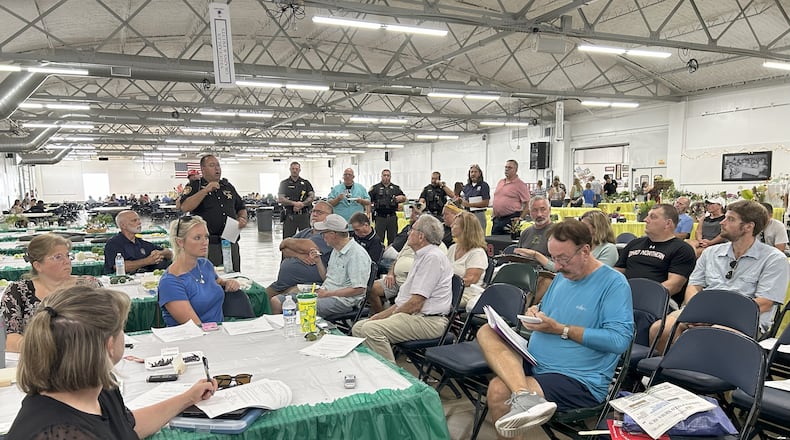Every year, the jail is evaluated by the Ohio Department of Rehabilitation and Corrections (ODRC) on their operations, policies and procedures.
In 2024, they were complying with 162 standards, 50 essential and 112 important. They were found to be non-compliant with 14 standards, including three essential and 11 important.
“Out of those 14 (non-compliant), 10 had to deal with the infrastructure of the jail. The other four were policy and procedures, and those either have been rectified or they’re in the process of being there,” Clark said.
The non-complaint standards have to do with not having enough square footage, Clark said. For example, there’s supposed to be one toilet and one sink per 12 inmates and 35 square feet per inmate living space, but they are out of compliance on those.
“Even if we were to modify our current jail at an exorbitant cost, we would probably lose bed space in order to become compliant with Ohio law and where we were supposed to be,” he said.
Overcapacity and limited space
The full-service, 9,200-square-foot jail was built in 1977 and opened in 1980 for $8.2 million. It was built as a 168-bed facility with three holding cells and 11 isolation cells.
Modifications were done in the early 2000s when 24 beds were added to the day rooms. However, those beds are outside of specifications, according to ODRC.
“It was constructed as a result of the federal court order of the Clark County Commission and the Clark County manager that they had to close the current jail due to conditions,“ Clark said. ”They had to take all the inmates out, and they had to put them someplace else in another county while they constructed this new jail.”
If that were to happen today, Clark said, with the cost being $90 per inmate per day to ship them out of the county, it would cost $6.2 million a year and $18.7 million over the construction time period.
“We’re not at that stage yet, but the conditions of the jail and the way we are progressing, it could come to that about any time,” he said.
Every year, the ODRC recommends the jail capacity is 167 inmates, but as of last week, there were 208. The average daily population for 2024 was 190.
“That’s an average of 23 inmates per day over what our population is supposed to be. That creates a whole other host of problems,” Clark said.
Due to this overcapacity, some people who allegedly commit certain types of crimes, like if your car or house gets broken into, the jail does not have enough space to take them in, Clark said.
“The expectation from the public is that if something happens to you, you expect someone who broke the law to go to jail. Unfortunately, we don’t have the capacity for that. We have to save room or free up room for violent offenders,” he said.
This puts a strain on law enforcement, judges and prosecutors because they have to make decisions on whether to put someone in jail since they need to free up space for the violent offenders, Clark said.
“We make those choices that the non-violent offenders get to go free. That’s a hard pill to swallow because what that does is that creates a situation that can actually increase our crime statistics,” he said.
Overcrowding causes other problems as well, such as health issues, bug issues, high tensions, fights, dangerous situations and violence.
The jail is also out of compliance with separation because they are supposed to separate misdemeanors, felonies, violent felonies and non-violent felonies, but they don’t have room for that.
Overdoses and opioids
Drug-related overdoses is something they’ve continuously seen in the jail, which they try to combat through the program they have, but they need more resources, Clark said.
“What we have is people come in who are addicted to heroin and the opioids. They spend a short amount of time in jail, so they lose their tolerance. They go outside, they try to reuse the same level that they did when they came in, and the end up overdosing and dying,” Clark said.
The jail has programs to help people overcome addiction, but the jail doesn’t have the facility to have an actual medication enhanced therapy program the sheriff’s office would like to see in the county, according to Clark.
This program helps inmates through a therapy process with counseling and doctor-prescribed medications that help them overcome their addiction and keep them from overdosing when they get out.
Disrepair
Another area the jail is out of compliance with is not properly keeping up with repairing the jail, even though the county is continually doing repairs to the facility, officials said.
“It’s just because there’s so much. There are things that are breaking, there are things that we constantly have problems with,” Clark said.
For example, they had a sewage flood in February, which cost them a lot of money to repair.
The jail has an annual maintenance fee of $431,465 a year for the more than 2,000 man hours to maintain and clean the facility. Other costs for repairs include:
- Installing a new roof would be $735,000
- Reconstructing the cracking entry plaza is $500,000
- Replacing the 50 years old jail locks with specialty made locks because the parts are not made for them anymore is $392,000
- Replace the HVAC equipment, boilers and chillers is $1 million
“The cost of maintaining an old building like this is quite expensive, and it’s just going up paying it year by year by year. It is a constant, constant battle maintaining and keeping the jail where it needs to be,” Clark said.
About the Author


